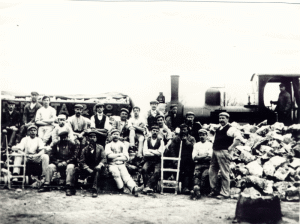| William
died on 5th September 1874, leaving his widow, Elizabeth
in control of the company. Redmond Cafferata, who
is said to have been a natural engineer despite a lack of formal
training, took over the company
in 1881. As the Beacon
Hill quarry was showing signs of giving out, Redmond decided
to look further afield. In 1897 he took a lease on an existing
quarry three miles away at Hawton. The lease was owned
by one Rev. John Holden, who was said to have bought the
land in anticipation of the future expansion of Newark in that
direction. The expansion never came, but the value
of the gypsum that was to be extracted - and is still being
extracted at Hawton - more than compensated.
R. B. Cafferata, who had joined
the firm in 1894, took charge of the Hawton undertaking. |

Quarrymen with steam
loco at Hawton |
|

Steam Compressor at
the Hawton Quarry |
The
quarry on the 158-acre Hawton site was, in fact, simply a circular
hole, 100 yards in diameter. The methods of extraction
were the same as at Beacon Hill. Having expanded and
ensured himself a gypsum supply for many years, Redmond Parker
modernised the plant and established his own large growing
family, of seven sons (an eighth son had died in infancy)and five
daughters, in Irnham Hall, near Corby, Lincolnshire.
A
sign of the spacious times was that the Great Northern Railway,
anxious to please in a regrettably out-dated manner, gave Redmond a
slip carriage of his own, to be attached to the
express passing through Newark at five in the evening, to take him
to Lincolnshire, where it was again slipped off. In fact, Redmond
only used this facility at weekends, spending weekday
nights in The Cottage at the
works. |